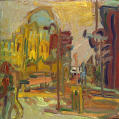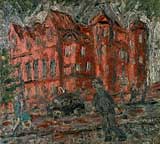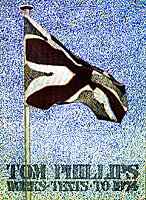|
GROUP EXHIBITIONS
selected

FRANK AUERBACH
Camden Palace Winter, 1999
oil on canvas source
Recent Trends in Realist Painting; Institute of Contemporary Arts, London (1952)
Dunn International; Beaverbrook Art Gallery, Frederiction and Tate Gallery, London (1963)
British Painting since 1945; Tate Gallery, London (1967)
Recent British Painting from the Peter Stuyvesant Collection; Tate Gallery, London (1967)
Helen Lessore and the Beaux Arts Gallery; Marlborough Fine Art, London (1968)
British Painting and Sculpture 1960-1970, an exhiition organized by the Tate Gallery and the British Council, London; National Gallery of Art, Washington, DC (1970-71)
Drawings of People; Arts Council of Great Britian (1975);
Serpentine Gallery (1976)
The Human Clay, an exhibition selected by R.B. Kitaj; Hayward Gallery, London; Arts Council of Great Britian (1976)
European painting from the Seventies: New York by 16 artists;
Los Angeles County Museum (1976)
Peter Moores Liverpool Project 4: Real Life
Walker Art Gallery, Liverpool (1976)
British Painting 1952 to 1977, The Royal Academy of Arts, London (1977)
The British Art Show, The Arts Council (1979)
This Knot of Life, paintings and drawings by British artists;
L. A. Louver Gallery, Venice California (1979)
Part I: William Coldstream, Lucian Freud, David Hockney, Howard Hodgkin, Euan Uglow
Part II: Frank Auerbach, Franics Bacon, Peter Blake, R. B. Kitaj, Leon Kossoff
"The urge to create art movements has almost become compulsive. The general confusion we have experienced in the art world of the Seventies has been the result of the art critics' and museum curators' desire to comfortably package newly found artists, and some of the barren prodcuts they have made during the past decade, into groups of related ideas. Now that their haste has succeeded in creating chaos, perhaps it has also afforded a period for the healthy reassessment of certain artists' work, and of aritstic values too hastifly abandoned. . .
In Britian, in spite of all the changes of fashion dictated by the art world itself, certain consistent ideas have prevailed. This exhibition brings together a group of British painters who are preoccupied with making pictures that explore the figure and human landscape. The influence of these artitsts has been birmly felt in Britian. To a generation of art students during the Sixties, their work was in many respects a guiding light. To a generation in the Seventies, their influence has been a thorn in the side of the argument that painting is dead. There are some great painters working in Britian. I have selected ten of them for this exhibition . . . I am very grateful to Ron Kitaj for agreeing to reprint, and edit, his essay entitled The Human Clay, which was written to accompany an exhibition her curated in 1976. . ."
Peter Goulds
5 October, 1979
Forward of catalogue
This Knot of Life
Narrative Paintings; Institute of Contemporary Arts, London (1979-80)
Eight Figurative Painters
Yale Center for British Art, New Haven, CT (1981)
artists: Michael Andrews, Frank Auerbach, Francis Bacon, William Coldstream, Lucian Freud, Patrick George, Leon Kossoff, Euan Uglow.
Exhibition at The Colony Room Club, organized by Michael Parkin (1982)
The exhibition which showed works by members Francis Bacon, Lucian Freud, Frank Auerbach
and Eduardo Paolozzi . . .
Hayward Annual, Hayward Gallery, London (1982)
The Hard Won Image, Tate Gallery, London (1984)
The British Art Show; Arts Council of Great Britian (1984)
A Circle: Portraits and Self Portraits by Arikha, Auerbach, Kitaj and Freud; Marlborough Fine Art, London (1984)
The Proper Study; The British Council (1984-85)
The British Show; Art Gallery of New South Wales, Sydney; British Council (1985)
A Singular Vision; Royal Albert Memorial Museum, Exeter (1985)
The Human Touch 50 years of British Painting about People; Cornerhouse, Manchester (1985)
Forty Years of Modern Art; Tate Gallery, London (1986)
British Art in the 20th Century: The Modern Movement
Royal Academy of Arts, London (1987)
Current affairs: British Painting and Sculpture in the 1980s; Museum of Modern Art, Oxford and The British Council (1987)
A School of London: Six Figurative Paintiners; organized by the British Council for: Kunstnernes Hus, Oslo; Louisiana Museum of Modern Art; Museo d'Arte Moderna, Venice; Kunstmuseum, Dusseldorf (1987)
"The idea for this exhibition arose from a discussion between the Paris-based art critic, Michael Peppiatt and the American-born aritst, R. B. Kitaj. . . this will be the first time that foreign audiences will be given the chance of seeing together a representative selection of work by some of the leading figures in what both Kitaj and the writer, Lawrence Gowing and others have chosen to dub the 'School of London.'
Michael Andrews, Frank Auerbach, Francis Bacon, Lucian Freud, R.B. Kitaj and Leon Kossoff; at first glance, it would seem that the members of this group possess little in common - certainly only one of them can claim to be a Londoner by birth, yet they all share an attachment to the city. The strongest link between them is their commitment to painting and to the figurative image. Their sustained dedication to an artistc ideal has resulted in a body of work of astonishing power and diversity which has been developed individually, and has remained largely unaffected by successive post-war artistc movements. . ." (from the catalogue)
Jenry Meyric Hughes
Director, Fine Arts Department
The British Council
Exhibition Road, Painters at the Royal College of Art; Royal College of Art, London (1988)
The Pursuit of the Real, British Figurative Painting from Sickert to Bacon, Manchester City Art Galleries, The Barbican Art Gallery, Glasgow City Art Gallery (1990)
The School of London and their Friends, The Collection of Elaine and Melvin Menains, Yale Centre for British Art, Newberger Museum of Art (2000-01)
- The School of London and Their Friends
"The finest and most comprehensive collection of paintings by the School of London are currently owned by New York collectors Elaine and Melvin Merians. For the first time over seventy masterpiece paintings and drawings from this collection will be exhibited publicly at the Yale Center for British Art. . .
The term "School of London" was coined by American-born painter Ronald Kitaj in order to draw attention to the extraordinary range and power he found in contemporary British art after the Second World War. The expression called attention to a common trait shared by half a dozen of London's most prominent artists: their fascination with the human figure as well as the environment�whether it was the interior of their studios or the grimy streets of London. Lucian Freud serves as one of the original members of the movement together with Leon Kossoff, Frank Auerbach, Michael Andrews, R.B. Kitaj, and Euan Uglow. Through their commitment to portraying the human figure, the landscape, and the cityscape, the School of London has influenced a younger generation of painters. They are represented in this exhibition by Christopher Bramham, Peter Doig, Tony Bevan, and others who are united by their engagement with the immediate world�from rich, dramatic depictions of the human form to crowded urban landscapes.
As a school they are a potent reminder of the tradition of modern British realist painting that extends through the twentieth century to such important artists from Walter Sickert and the Camden Town School, back to Matthew Smith, Paul Nash, and Wyndham Lewis. For many, their roots in London and London studio practice are strong and self-evident. For others removed from the London scene, such as David Hockney, there still persists a grip on the immediacy of place. The painters live and work off of the environment. The relationship is strong and unbreakable.
The collection of Elaine and Melvin Merians is of exceptional interest and quality as the foremost collection in America and Britain devoted exclusively to the School of London. It is the breadth of the Merians' vision and the depth of their relationship with each artist that the Yale Center has sought to capture in this exhibition. Melvin Merians commented, "�We have gotten to know most of the artists over a period of time. One of the great things about collecting contemporary art, I feel, is to know and have a relationship with the artist. It gives a greater insight into their work and one has an opportunity to ask them all sorts of questions."
Indeed, the Merians are collectors whose sharp focus on the School of London has given them an intimate knowledge of both the works of art and the artists who created them. The exhibition includes multiple works by nearly every featured artist including, for example, three paintings by Lucian Freud, five works each by R.B. Kitaj and Frank Auerbach, six paintings by Peter Blake and nine by Euan Uglow. . . ."

LEON KOSSOFF
The Red Brick School Building
RELATED EXHIBITIONS
- New Images of Man, by Peter Selz, Museum of Modern Art, NY, 1959
selected British artists: Kenneth Armitage, Francis Bacon, Reg Butler, Eduardo Paolozzi
- Representation Abroad, by Joe Shannon; Hirshhorn Museum and Sculpture Garden, Washington DC, 1985
selected artists: Avigdor Arikha, Arthur Boyd, Juan Arroyo Cárdenas, Luciano Castelli, Tibor Csernus, Sandra Fisher, Klaus Fussmann, David Hockney, Antonio López-Garcia, Leonard McComb, Luis Marsans, Francesco Messina, Rodrigo Moynihan, Isabel Quintanilla
  
images:
left: LEONARD McCOMB, RBA, Doris Lessing, 1999, NPG
middle: AVIGDOR ARIKHA, Self Portrait
right: LOUIS KAHAN (b. 1905), Arthur Boyd, 1972
- Identity and Alterity (Identitá e Alteritá): figures of the body 1895/1995, la Biennale di Venezia, 1995
| Biennale 1995 | Artivisive | Forms of the Body 1895-1995 |
"The ['School of London'] movement began in 1945 with the exhibition of Bacon's triptych Three studies of figures at the base of the crucifixion at the Lefévre Gallery; [Michael] Andrews joined it it in 1952 when he showed his work at the Beaux-Arts Gallery in London. The characteristic features of the movement . . . are the focus on the figurative and the interest in the understanding and practice of painting, an attitude that leads to isolation in an all-consuming dedication to painting. The painting The Colony Room is considered the School's icon; it portrays a well-known Soho bar, 'The Colony', frequented by some of these 'hermit' artists in the Sixities . . ." by Rosanna Alberti from the catalogue
Related chapters:
- Chapter VI: The Post-war Period 1945-1962
- On the Sidelines: the Unmanageable, the Resistant.
- Chapter VII: The Return of the Body 1962-1985
- The Turning-point 1962-1973
- Human Clay 1973-1985

JACOB EPSTEIN source
other British artists:
- Michael Andrews (UK Norwich, 1928)
- Helen Chadwick (UK Croydon, 1953)
- Tony Cragg (UK Liverpool, 1949)
- Jacob Epstein
(UK New York, 1880 - London, 1959)
- Barry Flanagan (UK Pestatin, 1941)
- Henri Gaudier-Brzeska (1891-1915)
- Andy Goldworthy (UK b. 1956)
- Raymond Mason
(Brimingham, 1922 - scupture, moved to Paris,1946)
- William Roberts (London, 1895-1980)
- Stanley Spencer
(Cookham-on-Thames, Berkshire, 1891-1959)
- Tony Stubbing (London, 1921 - London, 1983)
- Henry Tonks (Solihull, 1862 - London 1937)

RAYMOND MASON
SELECTED PUBLICATIONS
- John Rothenstein, Modern English Painters; originally published in 1952, Great Britian
- Revised edition: St. Martin's Press, New York, 1976
- Volume I: Sickert to Smith
- Volume II: Lewis to Moore
- Volume III: Wood to Hockney
- Newly revised edition: Macdonald & Co, Ltd, London, 1984
- Volume One: Sickert to Lowery
- Volume Two: Nash to Bawden
- Volume Three: Hennell to Hockney. The lives and works of twenty-one artists, including new essays on Thomas Hennell, Eric Ravilious, Michael Rothenstein, Alan Reynolds, Elisabeth Frink and Euan Uglow.
- Helen Lessore, A Partial Testament: Essays on Some Moderns in the Great Tradition [Cézanne, Giacometti, Aitchinson, Andrews, Auerbach, Bacon, Balthus, Freud, Kossoff, Lindquist, Mason, Uglow]; Tate Gallery, London, 1986
- Alistair Hicks, The School of London: the resurgence of contemportary painting; Phaidon Press, Oxford, 1989 [ISBN 0 7148 2511 5]
British painting has never been so strong. This book is intended as a celebration of tis fact and not as a comprehensive survey of British art. It is about the School of London. In line with Kitaj's original use of the term I have extended the School of London beyond the eight or so painters to whom the lavel has most frequently been attached. I have chosen twenty-four painters who are, or have been, centred round London and whose work most clearly explains the renaissance that has begun, and continues, to take place in Brition. . .
Alistair Hicks
from Preface of
The School of London
- Alistair Hicks, New British Art in the Saatchi Collection; Thames and Hudson, London, 1989
- R. B. Kitaj, First Diasporist Manifesto; Thames and Hudson, London, 1989
- Edward Lucie-Smith, Art in the Eighties; Phaidon Press, Oxford, 1990
LINKS
- Letter from London by David Cohen (5-5-97)
- XPOhaas Nostalgia Creativity Entertainment
- Museum of London: Soho 1950s Introduction
"Since the mid 19th century Soho had been an island of un-Britishness in the heart of London's West End. By the 1950s it was an exotic run-down area, offering after-hours drinking, hedonism, sexual adventure and a cosmopolitan lifestyle. Artists associated with Soho came to socialise rather than to live. Francis Bacon and his artist friends were among the best known painters who frequented the district's clubs, galleries and restaurants during the 1950s."
Further information about Soho is available through these links:
| Creative Quarters | artist list | Copyright | e-mail |

Photograph by John Deakin, 1962


click out of this page to return
Silkscreen of Bacon by R.B. Kitaj
|











